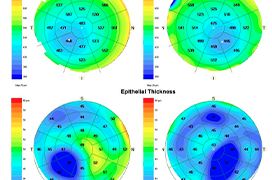Purpose: To evaluate the value of AS OCT pachymetry as a method capable of detecting early differences between keratoconus, latent keratoconus and corneal astigmatism based on measurements of the parameters of corneal epithelial thickness and total corneal thickness.
Methods: This study analyzed 162 eyes of 89 patients examined with a Zeiss Cirrus 500 Anterior Segment Premier Module. OCT Pachymetry maps were created in 97 eyes with keratoconus, 33 eyes with latent (forme fruste) keratoconus, and 32 eyes with regular corneal astigmatism (≥ 1.5 Dcyl). The parameters of epithelial thickness (central epithelial thickness in the 2 mm zone, paracentral epithelial thickness in the 2–5mm zone, minimal and maximal epithelial thickness) and total corneal thickness (S-I in the 2–5 mm zone, SN-IT in the 2–5 mm zone, minimal thickness, max-min thickness) were analyzed in all pachymetry maps.
Results: Statistically significant differences were determined in 3 parameters of epithelial thickness (paracentral epithelial thickness in the 2–5 mm zone, minimal epithelial thickness, maximal epithelial thickness) between group A and group B (p < 0.001), as well as between group A and group C (p < 0.001). Statistically significant differences were determined in 3 parameters of total corneal thickness (S-I in the 2–5 mm zone, SN-IT in the 2–5 mm zone, minimal thickness) between group A and group B (p < 0.001), between group A and group C (p < 0.001), as well as between group B and group C (p < 0.001).
Conclusion: AS OCT Pachymetry maps are a reliable method capable of detecting differences between keratoconus and corneal astigmatism based on the comparison of paracentral epithelial thickness in the 2–5 mm zone, minimum epithelial thickness, and maximum epithelial thickness. Furthermore, based on the evaluation of the parameters of total corneal thickness, it is a method capable of defining the differences between keratoconus, latent keratoconus and corneal astigmatism (S-I in the 2–5 mm zone, SN-IT in the 2–5 mm zone and minimum thickness). In the statistical analysis, the most reliable parameters appear to be: the difference between groups A, B and C in the parameters S-I in the 2–5 mm paracentral zone, SN-IT in the 2–5 mm paracentral zone and in the values of minimum corneal thickness.

